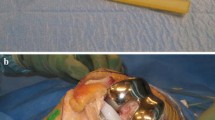Abstract
Introduction
Correct ligamentous balancing is an important determinant of the clinical outcome in total knee arthroplasty (TKA). Many surgeons prefer a tight rather than a lax knee during implantation of a TKA. The hypothesis in this study was that patients with a slightly laxer knee joint might perform better than patients with a tight knee joint after implantation of a TKA.
Patients and methods
Twenty-two patients with bilateral knee arthroplasties were clinically and radiologically evaluated at a mean follow-up of 4.5 years, ranging from 2 to 7 years. There were 12 women and 10 men with an average age of 68.9 years (range 32–82 years) at the time of surgery. A modified HSS score (excluding laxity), varus and valgus stress X-rays in 30° of knee flexion, and the subjective outcome of both knees were compared. A knee was considered tight when it opened less than 4° and lax if it opened 4° or more on stress X-ray.
Results
There was a trend towards improved range of motion and HSS score for the laxer knee joints. However, the difference did not achieve statistical significance. Eleven of the 22 patients considered one side subjectively better than the other side. In 10 out of these 11 TKA, the slacker knee joint was the preferred side (p<0.05).
Conclusions
As the present study compared bilateral knee joints after TKA, the same patient could act as a control group, and subtle subjective differences were revealed which are not quantifiable. The results showed that patients with a preferred side felt significantly more comfortable on the laxer side, indicating that during intraoperative ligamentous tensioning, some varus and valgus laxity at 20–30° of flexion might be preferable to an over-tight knee joint. Further biomechanical and prospective investigations will be necessary to establish the correct soft-tissue tensioning.

Similar content being viewed by others
References
Besson A, Brazier J, Chantelot C, Migaud H, Gougeon F, Duquennoy A (1999) Laxity and functional results of Miller-Galante total knee prosthesis with posterior cruciate ligament sparing after a 6-year follow-up (in French). Rev Chir Orthop 85:797–802
Edwards E, Miller J, Chan K (1988) The effect of postoperative collateral ligament laxity in total knee arthroplasty. Clin Orthop 236:44–51
Fehring T, Valadie A (1994) Knee instability after total knee arthroplasty. Clin Orthop 299:157–162
Insall J (1988) Presidential address to The Knee Society. Choices and compromises in total knee arthroplasty. Clin Orthop 226:43–48
Insall J, Dorr L, Scott R, Scott W (1989) Rationale of the Knee Society clinical rating system. Clin Orthop 248:13–14
Pagnano M, Hanssen A, Lewallen D, Stuart M (1998) Flexion instability after primary posterior cruciate retaining total knee arthroplasty. Clin Orthop 356:39–46
Pellengahr C, Jansson V, Durr H, Refior H (1999) Significance of sagittal stability in knee prosthesis implantation--an analysis of 76 cases with unconstrained joint surface replacement (in German). Z Orthop 137:330–333
Sanchez-Sotelo J, Ordonez J, Prats S (1999) Results and complications of the low contact stress knee prosthesis. J Arthroplasty 14:815–821
Warren P, Olanlokun T, Cobb A, Walker P, Iverson B (1994) Laxity and function in knee replacements. A comparative study of three prosthetic designs. Clin Orthop 305:200–208
Waslewski G, Marson B, Benjamin J (1998) Early, incapacitating instability of posterior cruciate ligament-retaining total knee arthroplasty. J Arthroplasty 13:763–767
Yamakado K, Kitaoka K, Yamada H, Hashiba K, Nakamura R, Tomita K (2003) Influence of stability on range of motion after cruciate-retaining TKA. Arch Orthop Trauma Surg 123:1–4
Author information
Authors and Affiliations
Corresponding author
Rights and permissions
About this article
Cite this article
Kuster, M.S., Bitschnau, B. & Votruba, T. Influence of collateral ligament laxity on patient satisfaction after total knee arthroplasty: a comparative bilateral study. Arch Orthop Trauma Surg 124, 415–417 (2004). https://doi.org/10.1007/s00402-004-0700-7
Received:
Published:
Issue Date:
DOI: https://doi.org/10.1007/s00402-004-0700-7




